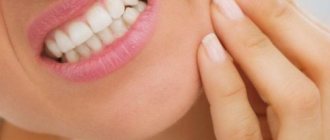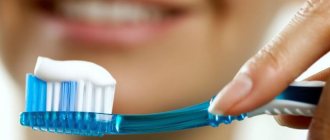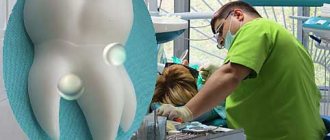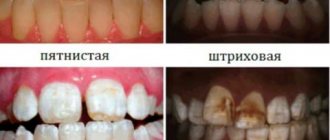- What are the benefits of fluoride?
- Why is fluoride deficiency dangerous?
- If there is too much fluoride in the body
- Fluoride products for teeth
- Water fluoridation
- Fluoride in toothpastes
- Can children have toothpaste with fluoride?
- Is there an alternative?
Most dental and oral care products contain fluoride. This is an important substance that helps strengthen enamel and prevents the spread of pathogenic microflora.
In the body, fluoride is contained in tooth enamel and bones in an amount of about 2.5–3 g. Our daily need for it is 1.5–5 mg. With a lack of this element, caries forms on the teeth. Therefore, in the USA and some European countries, fluoride is recommended for addition to drinking water and toothpastes.
Recently, articles have increasingly appeared that fluoride in toothpaste is harmful. Is it true? Let's try to figure it out.
What are the benefits of fluoride?
Fluoride performs important tasks in the body.
- Together with phosphorus and calcium, it participates in the formation and strengthening of bone tissue and tooth enamel
. - Promotes healthy nail and hair
. - Stimulates hematopoietic
: formation, development and maturation of red blood cells, platelets and leukocytes. - Strengthens the immune system
and maintains it at an appropriate level. - Removes salts of radionuclides and heavy metals
.
When used in oral care products, fluoride helps prevent dental problems and solve existing ones.
- Prevent tooth decay
. Fluoride penetrates the enamel structure, prevents caries and treats it at the white spot stage. - Protect against demineralization
. The combination of fluorine with hydroxyapatite (the main element of tooth enamel) forms fluorohydroxyapatite, a substance that restores it. This is how enamel remineralization occurs. - Protect against lactic acid
. Fluoride prevents bacteria from producing lactic acid. This reduces the growth of pathogenic microflora and gives the enamel additional protection.
Forms of fluorosis
The first signs of damage are changes in the structure and color of the enamel. White or lighter areas (stripes, spots) appear on its surface, and the surface structure may change. Gradually these areas change color. The affected surface absorbs dyes from food and drinks better, causing it to turn yellow and then darken. Its structure continues to change, teeth lose strength, abrasion of chewing surfaces accelerates, chips and pockets of erosion may appear, even to the destruction of crowns.
Dentists distinguish five forms of fluorosis.
Lined. Most often it appears on the frontal surface of the incisors. At the initial stage, stripes or streaks of a light, whitish color appear. The structure of the enamel changes; the changed areas are more visible if its surface dries. Gradually, individual stripes may increase in size and form spots, but even in this case it is noticeable that the affected area is formed by streaks.
Spotted. At the first stage, small whitish spots appear, which then merge with each other, covering more and more of the surface of the crown. These areas remain smooth and retain their shine. They do not have clear boundaries and smoothly merge with a healthy, unchanged surface.
Chalky speckled. A more dangerous type of disease in which the structure of hard tissue changes. The process begins with the enamel losing its gloss and natural shine. The areas that have become dull gradually become colored, noticeable spots, specks or dots appear. Their color changes from yellow to brown, and after the surface darkens, it begins to collapse. Small areas of erosion with a colored bottom are formed. The strength of teeth decreases, and their wear accelerates. Dentin also darkens, gradually acquiring a brown color.
Erosive. A dangerous manifestation of fluorosis. Hard tissues are destroyed, eroded areas form on the surface of the crowns, their size gradually increases, until the complete absence of enamel. The abrasion of the chewing surfaces accelerates, dentin is exposed and destroyed, the pathological process affects the pulp, and inflammation begins, threatening tooth loss.
Destructive. Rarely encountered, this form is the most severe. It is characterized by the formation of multiple erosions, rapid abrasion of hard tissues, exposure and destruction of dentin. Crowns break off, crack, collapse, and become very fragile.
The described forms of fluorosis develop independently of each other (they do not transform into one another). One patient may develop lesions of different types on different teeth. In other cases, only one type of disease appears, and the affected area does not increase over time.
Do you have questions about fluorosis?
We will call you back within 30 seconds
+7
If there is too much fluoride in the body
Fluoride is found not only in oral care products and tap water, but also in food.
The maximum permissible daily intake is 10 mg. Other causes of excess fluoride:
- chronic intoxication with fluoride compounds at work;
- improper regulation of fluoride metabolism in the body.
An excess of fluoride is more dangerous for the body than a deficiency, as it entails irreversible processes. First of all, teeth and bones are affected; metabolic disorders, deterioration of blood clotting, etc. may occur. In children, even before teething, endemic fluorosis develops - this is a chronic lesion of tooth enamel in the form of spots of various sizes, shapes and colors. After 10–20 years of excess fluoride in the body, bone fluorosis develops, which can develop into osteosclerosis, osteoporosis and osteosarcoma (malignant formation).
Progress, complications and prognosis
Make sure fluoride medications are not available to young children.
Gradient
Typically, symptoms of fluoride poisoning occur in less than 1 hour. However, in some cases, symptoms do not appear until several hours after ingestion.
Complications
· The cause of death is usually circulatory or respiratory failure.
· Damage to the liver and kidneys occurs.
· Repeated and long-term abuse of fluoride can lead to dental or skeletal fluorosis.
Forecast
Most exposures resolve without any symptoms. Fluoride poisoning is common in young children, but the condition can be prevented by keeping tablets and the like out of the child's reach.
Ingestion of toothpaste containing F is also common in children. Poisoning is rarely life-threatening and usually does not cause complications.
Fluoride in toothpastes
The fluoride concentration in toothpaste is measured in ppm or percentage. The abbreviation ppm stands for parts per million and reflects the number of fluorine particles per million. If the tube states that the paste contains 900 ppm of fluoride, this means that 1 kg will contain 900 mg of this element.
The higher the fluoride concentration, the better the paste restores enamel. For prophylactic pastes it is 950–1150 ppm, for therapeutic pastes it is 1350–1500 ppm.
Fluorine in pastes can be found in various compounds: amino fluorides, sodium fluorides, sodium monofluorophosphates, tin fluoride.
| Component | Name on the tube | A comment |
| Sodium monofluorophosphate | Sodium monofluorophosphate | It is ineffective because due to the rate of decay it begins to act only after 3–4 minutes of cleaning. |
| Sodium fluoride | Sodium fluoride | Has a powerful antibacterial and restorative effect. The active substance reduces the ability of bacteria to convert sugar into acid, which destroys enamel. |
| Aminofluoride | Aminofluoride/Olaflur | Recognized as the most effective for caries prevention. Forms a protective film on the surface of the teeth, from which fluoride enters the enamel and strengthens it. |
| Tin fluoride | Stannous fluoride | It is proven effective, but has a side effect: it first lightens the restored areas of enamel, and then leads to their noticeable darkening. |
We recommend choosing pastes with sodium fluoride or amino fluoride.
Toothpastes with sodium fluoride
Toothpaste CURAPROX Enzycal 1450
miradent mirasensitive hap+ toothpaste for sensitive teeth
Blanx Advanced Whitening Toothpaste
Toothpastes with amino fluoride
miradent Mirafluor C toothpaste
Elgidium toothpaste Protection against caries
Toothpaste ROCS (ROCS) Teens The aroma of a sultry summer. Strawberries (from 8 to…
Benefits of fluoride for teeth
The positive impact of microelements on the condition of teeth is difficult to overestimate. This is why fluoride toothpaste is widely advertised and recommended by dentists. The benefits of microelements for dental health are as follows:
- Fluorides improve metabolism.
- Fluoride stimulates the production of the salivary gland and slows down the formation of tartar.
- Fluoride ions inhibit the activity of harmful microorganisms in the oral cavity and prevent their destructive effects on tooth enamel.
- The trace element promotes tissue remineralization, i.e. allows you to restore damaged areas of teeth.
- Fluorides provide caries prevention.
Can children have toothpaste with fluoride?
The European Academy of Pediatric Dentistry (EAPD) recommends fluoride pastes and gels for everyone - even children and pregnant women - to prevent early stages of tooth decay. Children can begin brushing their teeth with fluoride-containing toothpastes when their first tooth erupts.
Recommended fluoride content in toothpaste:
- up to 4 years
- 200 ppm; - from 4 to 8 years
- 500 ppm; - over 6 years old
and for adults - 1450 ppm.
This recommendation is suitable for anyone living in areas with moderate levels of fluoride in drinking water. Up-to-date information on the fluoride content of water in your region can be found on the website of your local water utility or in our table.
Symptoms
Symptoms of fluorosis largely depend on the form of the disease. With the streaked form, only an experienced dentist will be able to distinguish the early symptoms, while with the chalky-mottled or erosive form, the patient himself will pay attention to the formation of pigmented spots or erosions on the surface of the tooth enamel.
The main symptom of fluorosis is the appearance of stains on the surface of the tooth enamel, and in more severe forms of the disease - fragility of the tooth enamel , which is easily worn away almost to the edge of the gum.
Differential diagnosis consists of the ability to distinguish fluorosis at the spot stage from early caries. If caries mainly affects the cervical areas of the tooth crown, then with fluorosis the spots are located on the frontal and lingual surfaces of the teeth.
Is there an alternative?
With the right approach and judicious use, fluoride is an effective way to treat and prevent tooth sensitivity, caries and enamel demineralization. But, if you still have doubts, there is an alternative - pastes with synthetic hydroxyapatite.
This hydroxyapatite is completely identical to natural hydroxyapatite, the one that makes up tooth enamel. The substance is easily integrated into the crystal lattice of the enamel, strengthening it, reducing sensitivity and preventing the development of caries. The only drawback is that pastes with hydroxyapatite are more expensive than fluoride-containing ones.
Degrees of development
Dental fluorosis develops gradually, it does not occur day by day, it is a complex disease. Doctors distinguish three stages of development, in which tooth enamel suffers differently:
- I degree is characterized by the appearance of small spots on the surface of the tooth enamel or a milky white color on the floor, while not all teeth are affected, but only some;
- Stage II is characterized by the appearance of not only chalky spots, but also pronounced pigmented spots of brown or yellow color;
- The third degree is characterized by damage to most of the enamel on the surface of the tooth, while the crown is deformed, and the tooth enamel becomes soft and easily erased, practically not protecting the tooth from damage.
Prevention
In order not to rack your brains about how to get rid of fluorosis, it is necessary to take preventive measures. First of all, it is necessary to limit the intake of fluoride into the human body. To do this you need:
- change the source of water supply;
- using special filters to purify water from excess fluoride;
- use bottled water for drinking and cooking;
- consume as much milk, vegetables and fruits as possible;
- systematically take calcium supplements.
Paste for fluorosis should be selected together with a doctor and in no case should it contain fluoride. Otherwise, the risk of disease increases significantly.











